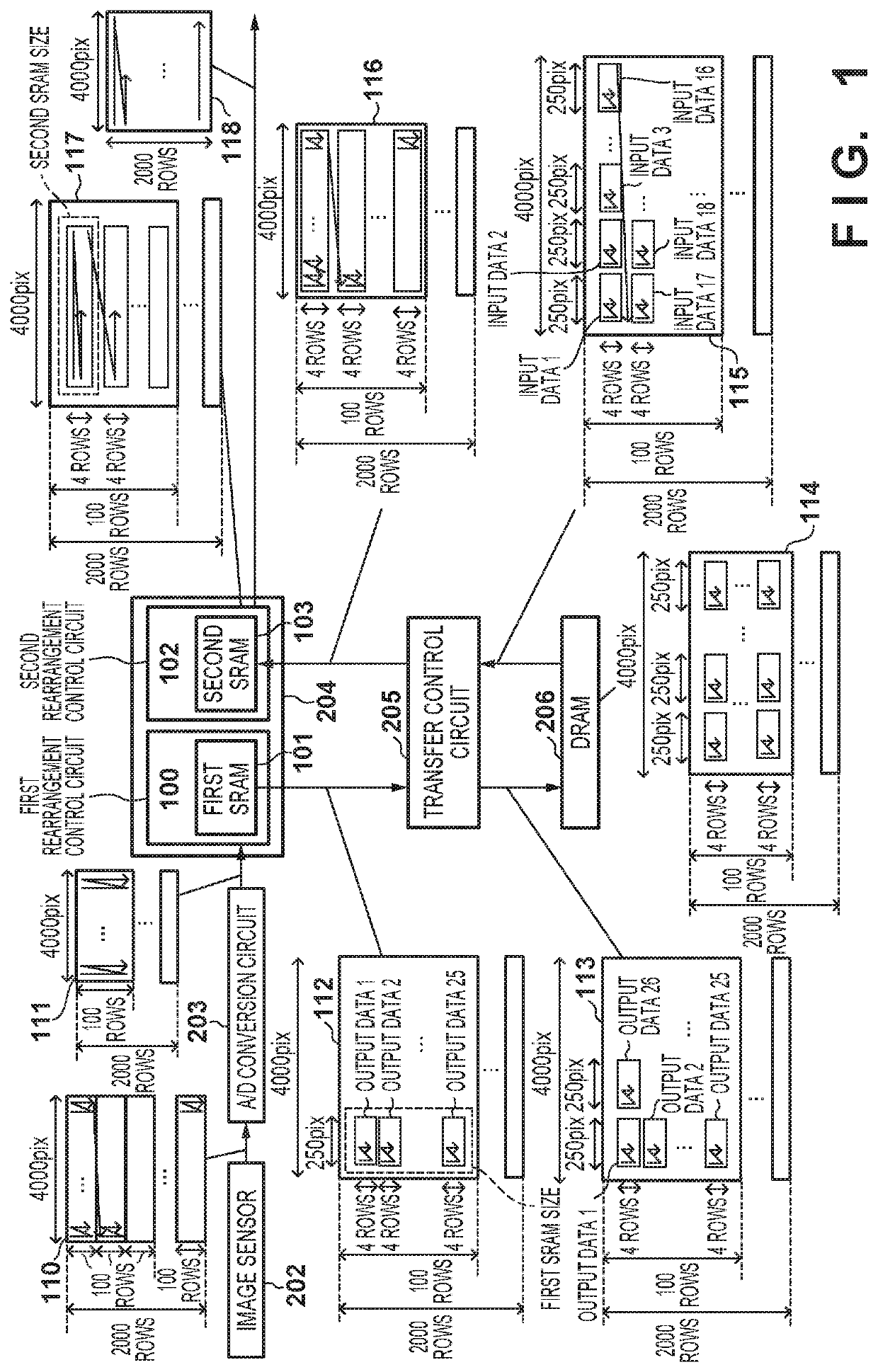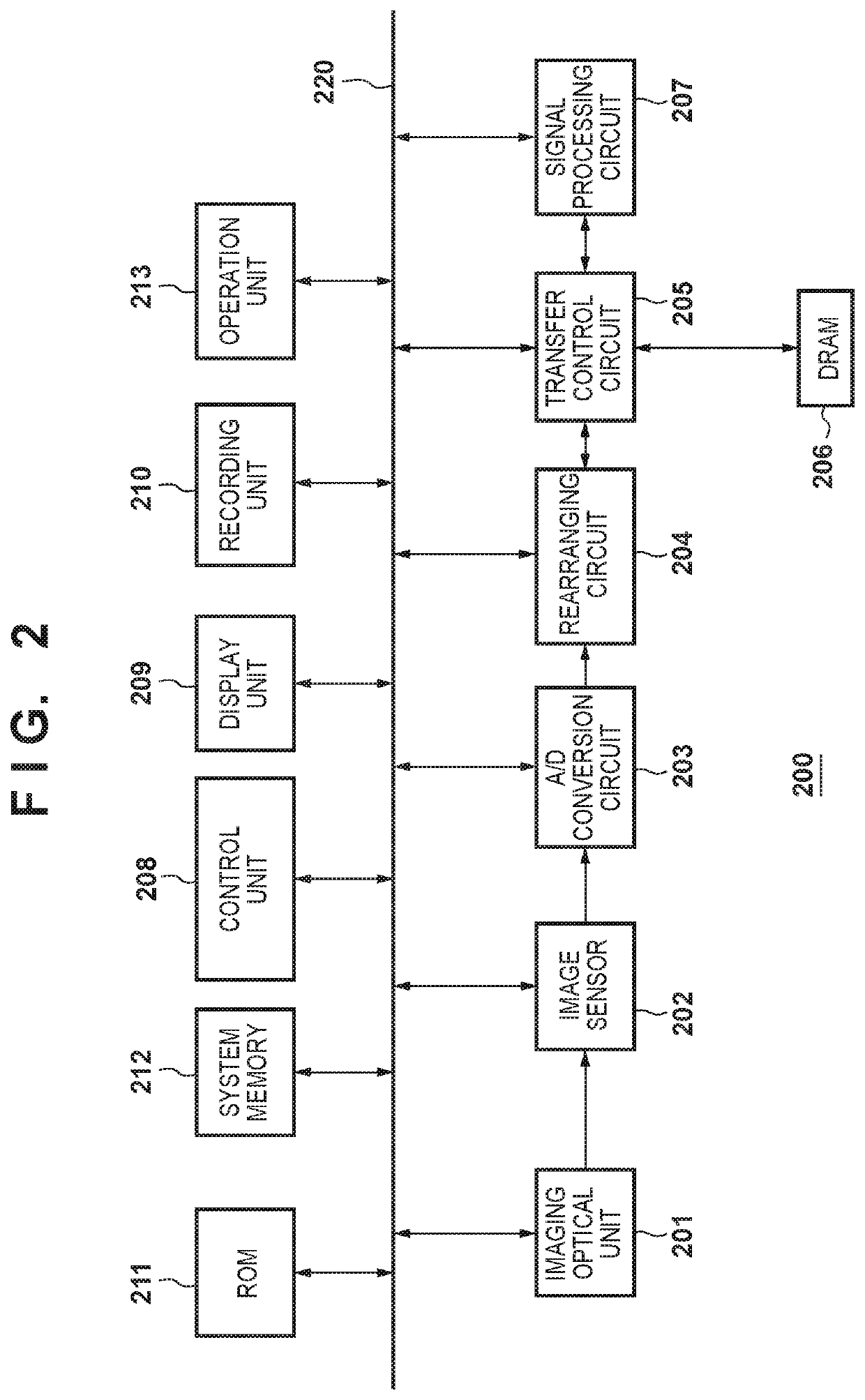Image processing apparatus and control method thereof
a technology of image processing and control method, which is applied in the field of image processing apparatus, can solve the problems of circuit scale and cost increase of rearranging data, and circuit processing rate drop in the later stage, and achieve the effect of small circuit scale and high speed
- Summary
- Abstract
- Description
- Claims
- Application Information
AI Technical Summary
Benefits of technology
Problems solved by technology
Method used
Image
Examples
first embodiment
[0024]FIG. 2 is a block diagram illustrating an example of the functional configuration of a digital camera 200 serving as an example of an image processing apparatus according to a first embodiment of the present invention.
[0025]An imaging optical unit 201 includes a plurality of lenses including a focus lens, an aperture stop, and driving circuits for the lens, the aperture stop, and the like. The imaging optical unit 201 may or may not be removable from the digital camera 200.
[0026]An image sensor 202 is a CMOS image sensor, for example, and includes a pixel array in which pixels, each including a photoelectric conversion unit, are arranged two-dimensionally, a horizontal scanning circuit and a vertical scanning circuit that supply control signals to the pixel array, and the like. The image sensor 202 has a mode in which signals are read out from the pixel array concurrently (in parallel) in units of a plurality of rows. In this mode, the data of one horizontally-arranged pixel (...
second embodiment
[0122]A second embodiment of the present invention will be described next. The present embodiment pertains to operations, carried out using the configuration described in the first embodiment, in which the number of rows read out from the image sensor 202 concurrently is not divisible by the number of rows in the first unit of rearrangement in the first SRAM (i.e., when m is not a multiple of o).
[0123]As an example, a case where 98 rows at a time are read out concurrently from the image sensor 202, and the first SRAM rearranges the data in units of four rows in the same manner as in the first embodiment (i.e., m=98 and o=4) will be described.
[0124]FIG. 10 is a diagram schematically illustrating the configuration according to the present embodiment, for rearranging 98 rows of data, which have been read out from the image sensor 202 concurrently, in the same order as if the data had been read out one row at a time. The configurations of the transfer control circuit 205 and the DRAM 20...
third embodiment
[0137]A third embodiment of the present invention will be described next. Like the second embodiment, the present embodiment pertains to operations, carried out using the configuration described in the first embodiment, in which the number of rows read out from the image sensor 202 concurrently is not divisible by the number of rows in the first unit of rearrangement in the first SRAM. The present embodiment differs from the second embodiment in that dummy pixels are not used.
[0138]To clarify the differences from the second embodiment, a case where 98 rows at a time are read out from the image sensor 202 concurrently, and the data is, like in the first embodiment, rearranged in units of four rows in the first SRAM, will be described as an example here.
[0139]FIG. 12 is a diagram schematically illustrating the configuration according to the present embodiment, for rearranging 98 rows of data, which have been read out from the image sensor 202 concurrently, in the same order as if the ...
PUM
 Login to View More
Login to View More Abstract
Description
Claims
Application Information
 Login to View More
Login to View More - R&D
- Intellectual Property
- Life Sciences
- Materials
- Tech Scout
- Unparalleled Data Quality
- Higher Quality Content
- 60% Fewer Hallucinations
Browse by: Latest US Patents, China's latest patents, Technical Efficacy Thesaurus, Application Domain, Technology Topic, Popular Technical Reports.
© 2025 PatSnap. All rights reserved.Legal|Privacy policy|Modern Slavery Act Transparency Statement|Sitemap|About US| Contact US: help@patsnap.com



